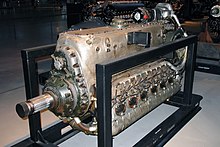| DB 601 | |
|---|---|

| |
| Preserved Daimler-Benz DB 601 | |
| Type | Piston V12 aircraft engine |
| National origin | Germany |
| Manufacturer | Daimler-Benz |
| First run | 1935 |
| Major applications | Messerschmitt Bf 109E-F |
| Number built | 19,000 |
| Developed from | Daimler-Benz DB 600 |
| Variants | Aichi Atsuta Kawasaki Ha-40 |
| Developed into | Daimler-Benz DB 603 Daimler-Benz DB 605 |




The Daimler-Benz DB 601 was a German aircraft engine that was built during World War II. It was a liquid-cooled inverted V12, and powered the Messerschmitt Bf 109, Messerschmitt Bf 110, and many others. Approximately 19,000 601s were produced before it was replaced by the improved Daimler-Benz DB 605 in 1942.
The DB 601 was basically an improved DB 600 with direct fuel injection. Fuel injection required power to be taken off the drive shaft, but in return, improved low-RPM performance significantly and provided aerobatic performance in maneuvers where early versions of carbureted engines like the British Rolls-Royce Merlin lost power when the carburetor float bowl ran dry.
The 601's fuel injection provided a significant boost in performance which its competitor, the Junkers Jumo 210, did not match for some time. By the time the fuel-injected 211 arrived, the 601 had already cemented its place as the engine for high-performance designs like fighters, high-speed bombers, and similar roles. The 211 was relegated to use in bombers and transport aircraft. In this respect, the 601 was the counterpart to the Merlin engine of roughly the same size and power.
The DB 601Aa was licence-built in Japan by Aichi as the Atsuta, by Kawasaki as the Ha40, and in Italy by Alfa Romeo as the R.A.1000 R.C.41-I Monsone.